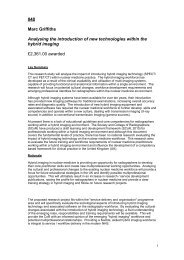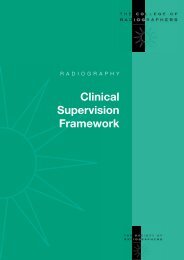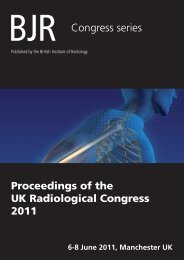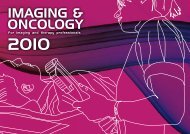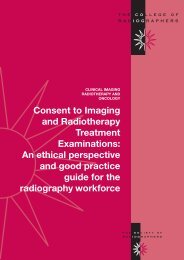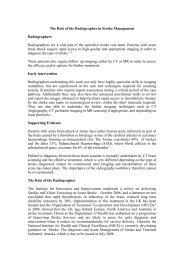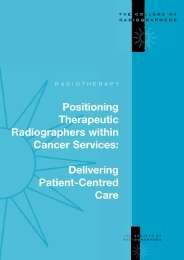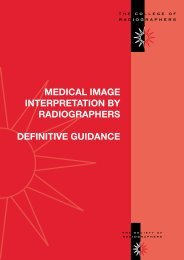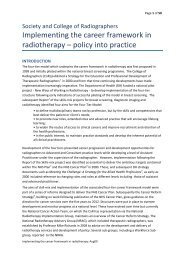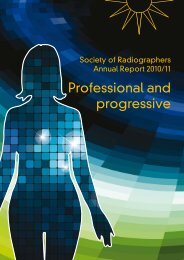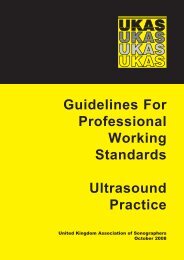SoR Brochure Child and Law SGG-82330 NEW - Society of ...
SoR Brochure Child and Law SGG-82330 NEW - Society of ...
SoR Brochure Child and Law SGG-82330 NEW - Society of ...
Create successful ePaper yourself
Turn your PDF publications into a flip-book with our unique Google optimized e-Paper software.
7. Education <strong>and</strong> training7.1 It would appear from the research carried out by Davis <strong>and</strong> others that radiographers are<strong>of</strong>ten omitted from child protection training sessions carried out in their place <strong>of</strong>employment. This must be urgently addressed. The Royal College <strong>of</strong> Nursing (RCN) arguesthat there should be m<strong>and</strong>atory child protection training for all health care workers whocome into contact with children <strong>and</strong> young people, this must include ancillary <strong>and</strong> <strong>of</strong>ficestaff 54 .7.2 <strong>Child</strong> protection training for radiographers, <strong>and</strong> other members <strong>of</strong> staff appointed to theradiology/radiotherapy department, should be provided as part <strong>of</strong> an induction programmeon appointment <strong>and</strong> updated on a regular basis.7.3 Issues surrounding child protection should be integrated into the curriculum in all preregistration radiography programmes. Assistant practitioner courses should ensure thatlearners on such courses attend the child protection training provided by their employer.7.4 Pre registration curricula should include issues surrounding child psychology <strong>and</strong> socialpsychology, including child development.7.5 The identification <strong>of</strong> the external physical signs <strong>and</strong> the subtle radiographic signs <strong>of</strong> nonaccidentalinjury must be part <strong>of</strong> the pre registration curriculum. Pre registration curriculashould also include imaging protocols <strong>and</strong> the issues surrounding the collection <strong>of</strong>evidence.7.6 Radiographers who undertake forensic radiography examinations, including NAI cases,must be educated <strong>and</strong> trained in all aspects <strong>of</strong> medico-legal issues relating to theadmissibility <strong>of</strong> evidence. Regular updating must form part <strong>of</strong> the radiographer’s continuingpr<strong>of</strong>essional development 43 .7.7 Good report writing is a requirement <strong>of</strong> any pr<strong>of</strong>essional <strong>and</strong> report writing skills shouldfeature in all pre-registration curricula. Where a report is likely to be used for litigationpurposes, however, radiographers should have access to local specific guidance on thestructuring <strong>of</strong> such reports.7.8 Diagnostic imaging examinations on children <strong>and</strong> radiotherapy treatments <strong>of</strong> childrenshould only be carried out by a registered radiographer <strong>and</strong> by undergraduate studentsstrictly supervised by a qualified radiographer.7.9 Assistant practitioners should never carry out any examinations on children under the age<strong>of</strong> 18 years as they have neither the pr<strong>of</strong>essional background nor statutory requirements <strong>of</strong>practice.18





